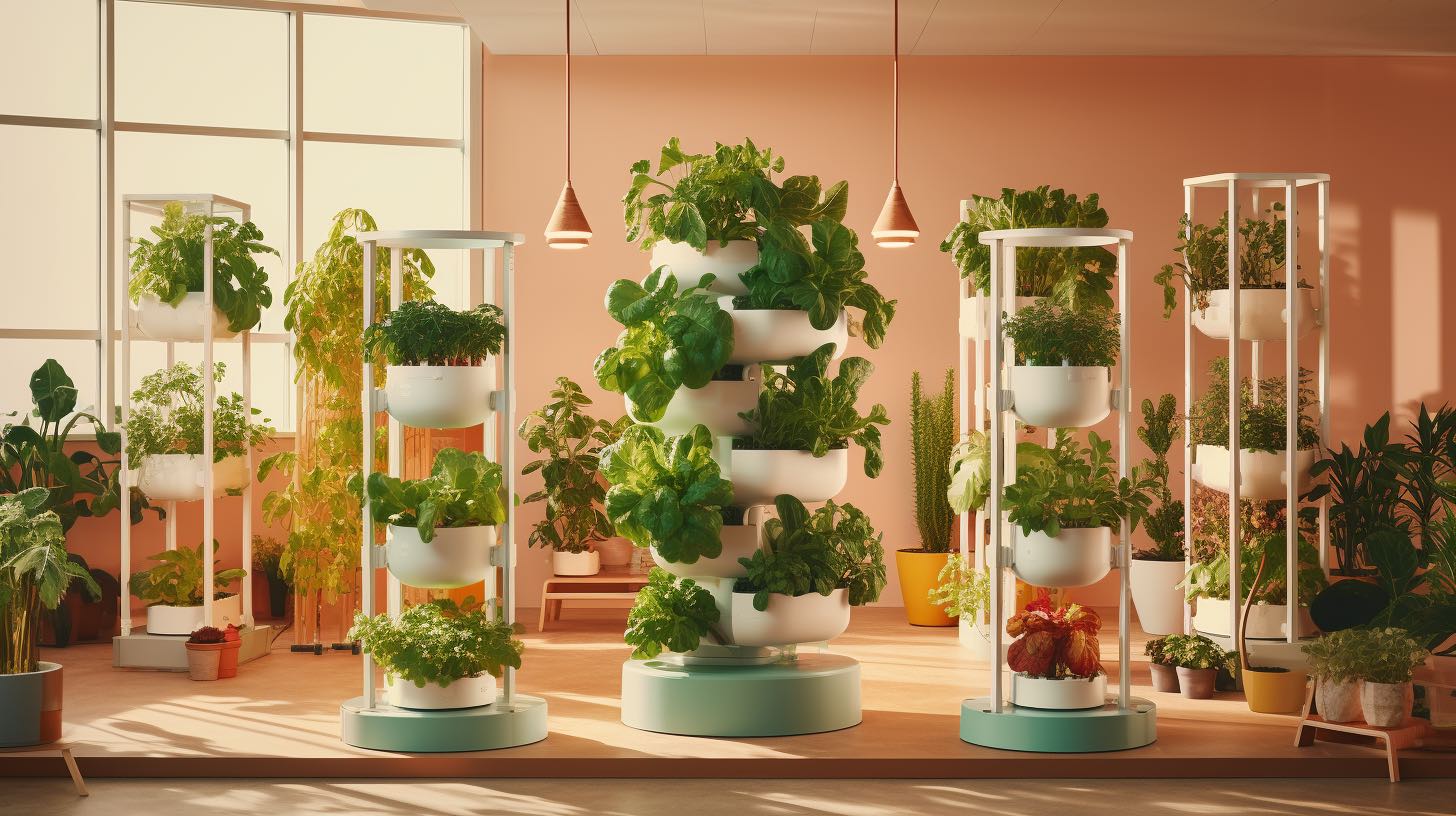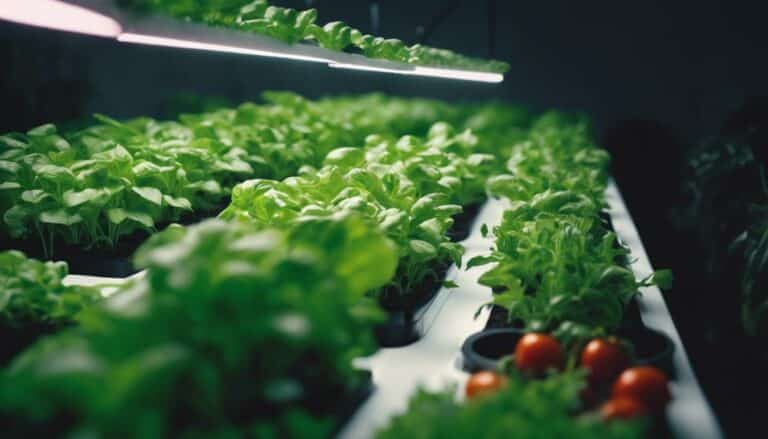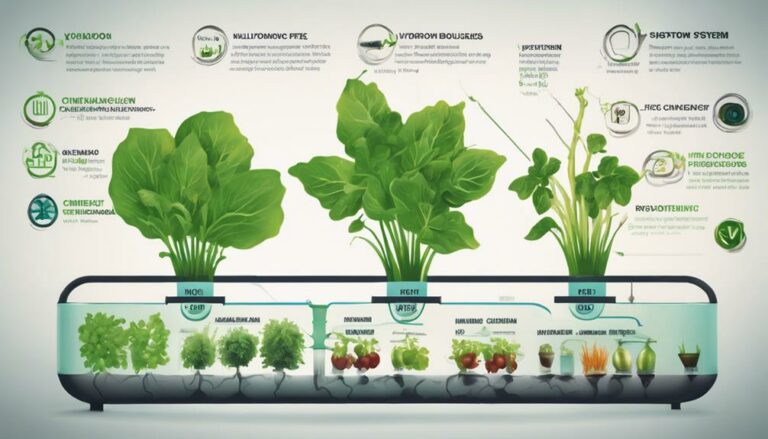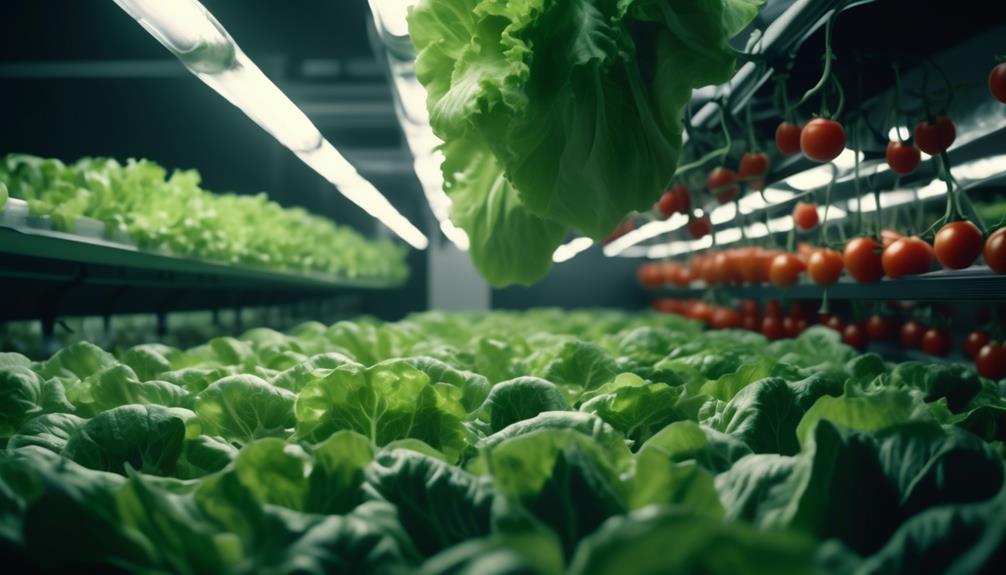Picture this: a world where plants levitate, rooted not in earth, but in pure, nourishing water. 🌱💦 That’s hydroponics for you – the future-forward twist to age-old agriculture, turning it on its head.
It’s like the maestro of an orchestra, seamlessly blending the art of nature with the rhythm of tech to create a green crescendo. 🎵🌿
Dive into this guide, and you’ll discover the shining stars of the hydroponic universe, from their shining moments to their occasional hiccups. Whether you’re a greenhorn or a gardening guru looking for the next big thing, we’ve got the lowdown to set you on a path to hydroponic heroism.
Ready to take the leap from soil to solution? Let’s make waves in the world of water-rooted wonders! 🚀🌾
Table of Contents
Key Takeaways
- The Wick System and Deep Water Culture (DWC) are basic and low-cost hydroponic systems suitable for beginners, but may not be suitable for larger plants or high water/nutrient requirements.
- Nutrient Film Technique (NFT) and Aeroponics are highly efficient hydroponic systems that use water and nutrient solutions to nourish the plants. NFT is ideal for leafy greens and herbs, while aeroponics is advanced and requires specialized equipment, but is suitable for a wide range of plants.
- Drip Irrigation System is a precise and efficient method of delivering water directly to plant roots, minimizing water wastage, reducing weed growth, and preventing foliar diseases. It is suitable for a wide range of plants.
- Ebb and Flow System and Vertical Tower System are other hydroponic systems. Ebb and Flow allows for the growth of various plants, while the Vertical Tower System maximizes space utilization and requires careful planning and monitoring. The Kratky Method and Dutch Bucket System are other options suitable for beginners, with the Kratky Method being a passive system and the Dutch Bucket System being a popular and versatile choice.
Which Hydroponic Systems Are Recommended for Beginners?
When exploring hydroponics for the first time, understanding hydroponic terminology is essential for beginners. It helps in comprehending the various hydroponic systems available and their functionalities. Some recommended options for beginners include Deep Water Culture (DWC), Nutrient Film Technique (NFT), and Ebb and Flow systems. Start your hydroponic journey by gaining a clear understanding of these terminologies to make informed decisions.
Basic Wick System
The Basic Wick System is a passive hydroponic system that relies on capillary action to deliver water and nutrients to the plants. This system is particularly suitable for beginners due to its simplicity and low cost.
One of the main advantages of the wick system is its ease of setup. All you need is a container filled with a nutrient solution, a wick made of a porous material such as cotton or nylon, and a growing medium for the plants. The wick acts as a conduit, drawing the nutrient solution from the reservoir and transporting it to the roots of the plants. This eliminates the need for pumps or electricity, making it a convenient option for those just starting out in hydroponics.
However, it’s important to note that the wick system has its limitations. It is not suitable for larger plants or those with high water and nutrient requirements. Additionally, the wick can sometimes become clogged, preventing proper nutrient delivery.
Despite these drawbacks, the Basic Wick System remains a viable choice for beginners looking to explore hydroponics.
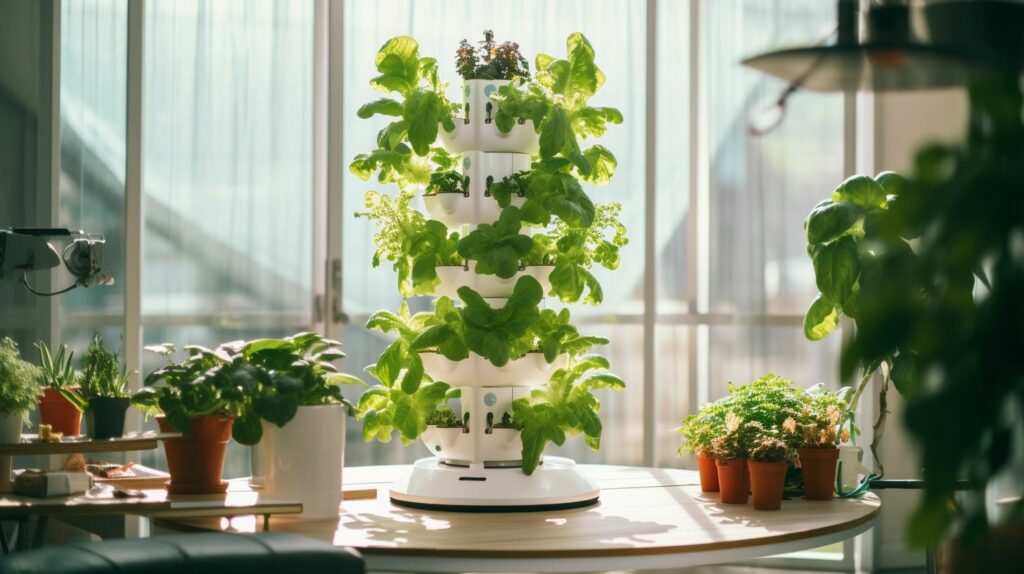
Deep Water Culture (DWC)
Deep Water Culture (DWC) is an ideal hydroponic system for beginners due to its simplicity and effectiveness. This system involves suspending plant roots in a nutrient-rich solution, allowing for maximum oxygenation and nutrient absorption.
However, it’s important to consider the advantages and disadvantages of DWC. One potential disadvantage is the potential for root rot, which can occur if the water is not properly oxygenated or if the roots are constantly submerged. To avoid this issue, it’s crucial to monitor oxygen levels and ensure that the roots have proper access to oxygen.
Another factor to consider with DWC is the need for constant monitoring of water levels and nutrient concentrations. Since the plants are completely dependent on the nutrient solution, it’s important to regularly check and adjust the levels to ensure that the plants are receiving the proper amount of nutrients.
Despite these potential challenges, DWC remains a popular choice for hydroponic gardening due to its simplicity and effectiveness. With proper care and monitoring, this system can provide excellent results for beginners and experienced growers alike.
DWC for Beginners
One recommended hydroponic system for beginners is the Deep Water Culture (DWC) system. DWC is a simple yet effective method that involves suspending plant roots in nutrient-rich water.
Here are some key aspects of DWC for beginners:
- DWC setup: The setup involves using a reservoir to hold the nutrient solution, an air pump to provide oxygen to the roots, and a net pot to hold the plant. The plant’s roots are submerged in the oxygenated water, allowing for efficient nutrient absorption.
- Benefits of DWC: This system offers several advantages, such as faster growth rates, increased yields, and minimal maintenance requirements. It is also suitable for a wide range of plants, including leafy greens, herbs, and even flowering crops.
- DWC vs NFT: DWC differs from Nutrient Film Technique (NFT) as it submerges the roots in water rather than providing a thin film of nutrient solution. DWC is often considered more beginner-friendly due to its simplicity and ease of setup.
- Monitoring and maintenance: Regular monitoring of pH and nutrient levels is crucial in DWC systems. Additionally, maintaining proper water temperature and preventing algae growth are important for optimal plant growth.
- Tips for success: To ensure success with DWC, it is essential to choose a suitable air pump, provide adequate lighting, and maintain proper water levels. Regularly checking the roots for any signs of disease or rot is also recommended.
DWC is an excellent choice for beginners who are looking for a straightforward and effective hydroponic system that can deliver impressive results.
DWC Advantages and Disadvantages?
A key aspect of the Deep Water Culture (DWC) system, discussed previously, is its advantages and disadvantages. Understanding these can help beginners make informed decisions when setting up their hydroponic systems.
One of the major advantages of DWC is its simplicity. This system is easy to set up and maintain, making it an ideal choice for beginners.
Additionally, DWC allows for excellent oxygenation of the roots, promoting faster growth and higher yields.
However, there are also some disadvantages to consider. DWC systems require regular monitoring of nutrient levels and pH to prevent imbalances that can harm plant health.
Another potential drawback is the risk of system failure due to power outages or equipment malfunctions.
Despite these cons, with proper care and attention, DWC can be a highly effective and efficient hydroponic system for beginners.
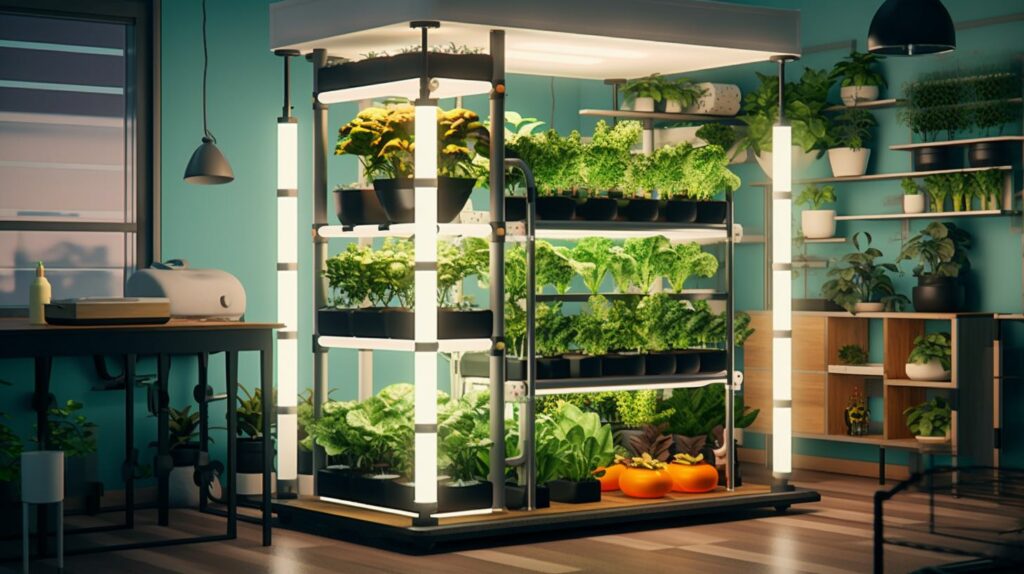
Nutrient Film Technique (NFT)
Regularly used in commercial hydroponic setups, the Nutrient Film Technique (NFT) is a highly efficient and widely adopted system for growing plants without soil. It involves a continuous flow of nutrient-rich water over the roots of the plants, creating a thin film that provides the necessary nutrients.
Here are some advantages of the Nutrient Film Technique:
- Efficient water and nutrient usage
- Reduced risk of overwatering and root diseases
- Easy nutrient management and adjustment
- Ideal for growing leafy greens and herbs
- Scalable for both small-scale and large-scale operations
To set up the Nutrient Film Technique, you will need a sloping growing channel, a nutrient reservoir, a submersible pump, and a timer. The nutrient solution is pumped from the reservoir to the highest end of the channel, allowing it to flow down and create the thin film over the roots. As the solution reaches the end, it is collected back into the reservoir for recirculation.
This constant flow ensures ample oxygenation and nutrient supply to the plants, promoting their healthy growth.
Aeroponics
An aeroponics system is a highly advanced hydroponic method that utilizes mist to deliver nutrients and water directly to the roots of plants. Unlike other hydroponic systems, aeroponics does not require a growing medium such as soil or water. Instead, plants are suspended in air, allowing their roots to be exposed to a fine mist of nutrient-rich water.
This method provides several benefits, including faster growth rates, increased nutrient absorption, and reduced water usage. Additionally, aeroponics allows for precise control over the nutrient and water delivery, resulting in healthier and more productive plants.
When setting up an aeroponics system, it is important to ensure proper misting nozzles, adequate ventilation, and a reliable nutrient solution. Regular monitoring and maintenance are also essential to prevent clogging and maintain optimal growing conditions.
Drip Irrigation System
The drip irrigation system is known for its efficiency in delivering water directly to the plant roots, minimizing water wastage and reducing the risk of diseases caused by overwatering. This system works by slowly dripping water through a network of tubes and emitters, ensuring that each plant receives the necessary amount of water and nutrients.
The benefits of using a drip system include improved water conservation, precise control over irrigation, and the ability to automate the watering process.
Efficiency of Drip Irrigation
Drip irrigation systems are known for their efficient water distribution in hydroponic gardening. This method involves delivering water directly to the plant’s root system, minimizing water loss due to evaporation or runoff. The efficiency of drip irrigation can be attributed to several factors:
- Precise watering: Drip systems deliver water directly to the plants, ensuring that each receives the appropriate amount needed for optimal growth.
- Reduced weed growth: By targeting the plant roots, drip irrigation reduces water availability to weeds, minimizing competition and the need for manual weeding.
- Conservation of water: Drip irrigation uses water more efficiently compared to traditional irrigation methods, resulting in significant water savings.
- Disease prevention: Drip irrigation keeps foliage dry, reducing the risk of foliar diseases caused by excess moisture.
- Suitable for a wide range of plants: Drip irrigation is suitable for various plants, including vegetables, fruits, herbs, and flowers, making it a versatile choice for hydroponic gardening.
Benefits of Drip System
Drip irrigation systems offer a multitude of advantages, making them an excellent choice for hydroponic gardening.
One of the major benefits of drip irrigation is precise watering. Unlike other irrigation methods, drip systems deliver water directly to the roots of plants, ensuring that each plant receives the exact amount of water it needs. This precision helps to prevent overwatering or underwatering, which can lead to plant stress or even death.
Another benefit of drip irrigation is reduced weed growth. By delivering water directly to the plants, drip systems minimize water exposure to the surrounding soil, depriving weeds of the moisture they need to thrive. This reduces the need for manual weeding or the use of herbicides.
Drip systems are also known for their water conservation capabilities. Since water is delivered directly to the plants, there is minimal water loss due to evaporation or runoff. This makes drip irrigation an efficient and sustainable option for water-conscious gardeners.
In addition to water conservation, drip irrigation systems help prevent disease. By keeping the foliage dry, drip systems reduce the chances of fungal or bacterial diseases that thrive in moist environments. This is especially beneficial for plants that are susceptible to diseases, such as tomatoes or cucumbers.
Furthermore, drip irrigation is suitable for a wide range of plants. Whether you are growing vegetables, herbs, or flowers, drip systems can be easily customized to accommodate different plant types and their specific water requirements. This flexibility makes drip irrigation a versatile choice for any hydroponic garden.
When it comes to the best plants for drip irrigation, there are several options to consider. Vegetables like tomatoes, peppers, and lettuce thrive in drip systems due to their specific watering needs. Herbs such as basil, rosemary, and mint also benefit from the precise and controlled watering provided by drip irrigation. Additionally, flowers like petunias, marigolds, and zinnias can flourish when watered through a drip system.
Ebb and Flow System
One popular hydroponic system for beginners is the Ebb and Flow System. This system, also known as the flood and drain system, is simple yet effective in providing plants with the necessary nutrients and oxygen. Here are some advantages of the ebb and flow system:
- Flexibility: The ebb and flow system allows for the growth of a wide range of plants, including vegetables, herbs, and flowers.
- Nutrient control: With this system, you have precise control over the nutrient solution, ensuring that your plants receive the optimal amount of nutrients.
- Oxygenation: The ebb and flow system periodically floods the root zone and then drains it, providing the plants with a fresh supply of oxygen.
- Easy maintenance: Setting up and maintaining an ebb and flow system is relatively easy, making it an excellent choice for beginners.
- Scalability: This system can be easily scaled up or down, allowing you to expand your hydroponic garden as desired.
When setting up an ebb and flow system, ensure that the flood table is level, use high-quality flood and drain fittings, and regularly check the water level to prevent overflows.
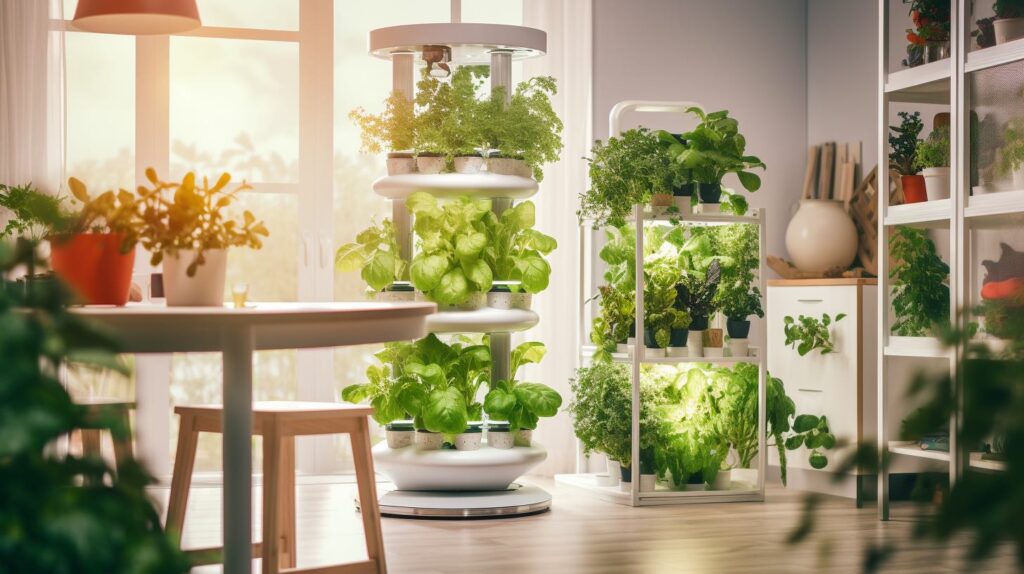
Vertical Tower System
Continuing the exploration of hydroponic systems for beginners, the next system to consider is the Vertical Tower System. This innovative system offers a unique approach to growing plants vertically, maximizing space utilization and increasing crop production. Vertical tower systems consist of stacked trays or tubes, allowing plants to grow upwards rather than horizontally.
One of the key benefits of the vertical tower system is its space-saving design. By utilizing vertical space, growers can maximize their crop yield in a limited area. This is especially beneficial for urban gardeners or individuals with limited gardening space. Additionally, vertical towers provide excellent air circulation and sunlight exposure, promoting healthy plant growth.
Setting up a vertical tower system requires careful planning and consideration. It is crucial to choose a sturdy structure that can support the weight of the trays or tubes. Additionally, proper irrigation and nutrient delivery systems should be implemented to ensure optimal plant growth. Regular monitoring of water levels and nutrient concentrations is essential for maintaining a healthy hydroponic environment.
Kratky Method
Now, let’s delve into the Kratky Method, an innovative hydroponic system that offers a unique solution for beginners.
The Kratky Method is a passive hydroponic system that requires no electricity or pumps.
Here are some pros and cons of the Kratky Method:
- Pros:
- Simple setup and low maintenance
- No need for continuous monitoring or nutrient solution adjustments
- Ideal for growing leafy greens and herbs
- Cost-effective as it eliminates the need for complex equipment
- Suitable for small-scale indoor gardening
- Cons:
- Limited to certain plant varieties
- Nutrient solution depletion can occur if not monitored properly
- Not suitable for larger plants or fruiting vegetables
- Risk of root rot if water levels are not properly maintained
- Difficult to scale up for commercial production
To set up a Kratky system, you will need a container, growing medium, net pots, nutrient solution, and plants.
Fill the container with the nutrient solution, place the plants in the net pots with the growing medium, and submerge the pots partially in the solution.
As the plants grow, the roots will reach the solution and absorb the necessary nutrients.
Monitoring the water level and replenishing the solution when needed is crucial for successful Kratky gardening.
Dutch Bucket System
The Dutch Bucket System is a popular hydroponic system that utilizes individual buckets filled with a growing medium to provide a controlled environment for plant growth. This system is known for its simplicity and versatility, making it a great choice for beginners in hydroponics. With proper dutch bucket maintenance, this system can yield impressive results.
One of the key advantages of the Dutch Bucket System is its ability to maximize plant yield. Each bucket is filled with a growing medium, such as perlite or coconut coir, which provides support and nutrients to the plants. Additionally, the buckets are connected to a nutrient reservoir, allowing for precise control over the nutrient solution.
To give you a better understanding, here is a table highlighting the key features of the Dutch Bucket System:
| Features | Benefits |
|---|---|
| Easy to set up | Quick installation process |
| Versatile | Suitable for a wide range of crops |
| Efficient nutrient usage | Maximizes plant yield |
| Minimal water wastage | Water is recirculated |
| Low maintenance | Simple to maintain and clean |
Frequently Asked Questions
How Much Maintenance Do Hydroponic Systems Require?
Hydroponic systems require regular maintenance to ensure they function optimally. The level of maintenance can vary depending on factors such as system complexity and plant type. It is important to consider the cost and time commitment when choosing a hydroponic system.
Are Hydroponic Systems Suitable for Growing All Types of Plants?
Hydroponic systems offer numerous benefits and advantages for growing a wide variety of plants. Their ability to provide precise nutrient delivery, optimize growth conditions, and conserve water make them suitable for cultivating various plant types, from leafy greens to flowering plants.
Can Hydroponic Systems Be Used Outdoors?
Outdoor hydroponic systems offer numerous benefits for gardening enthusiasts. The ability to harness natural sunlight, increased space for plant growth, and reduced reliance on traditional soil-based methods make outdoor hydroponics an innovative and efficient choice for cultivating various plants.
What Are the Potential Disadvantages of Using Hydroponic Systems?
Hydroponic systems offer numerous benefits, but it is important to consider their potential limitations. Some challenges include the need for precise nutrient management, potential system failures, and higher upfront costs. These drawbacks should be carefully evaluated before investing in hydroponics.
Can Hydroponic Systems Be Scaled up for Commercial Use?
Hydroponic systems can be scaled up for commercial use, but there are limitations to consider. Factors such as space, cost, and maintenance requirements must be carefully evaluated to ensure economic viability and successful implementation.
Conclusion
Wrapping it up, imagine stepping into the magical world of gardening, but with a futuristic twist. 🌱💧 From the no-fuss charm of the Basic Wick System to the high-tech vibes of Aeroponics and the skyscraping dreams of the Vertical Tower System, there’s a hydroponic dance for every green thumb out there.
Think of it as giving your plants VIP tickets to a nutrient spa. 🎟️💅 They get pampered, you get lush green results.
Ready to ditch the dirt and dive into the sleek waters of hydroponics? Let’s turn that indoor garden dream into a leafy, green reality! 🌿🚀

